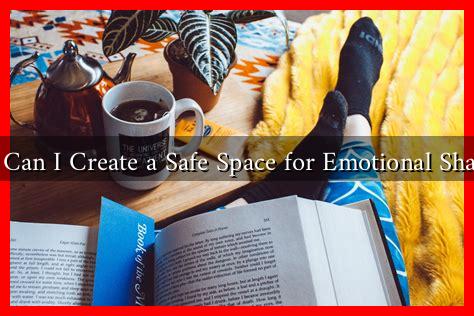-
Table of Contents
- How Can I Create a Safe Space for Emotional Sharing?
- Understanding the Importance of Safe Spaces
- Key Elements of a Safe Space
- Practical Strategies for Creating a Safe Space
- 1. Set Ground Rules
- 2. Foster Open Communication
- 3. Create a Comfortable Environment
- 4. Lead by Example
- Case Study: The Impact of Safe Spaces in the Workplace
- Conclusion
How Can I Create a Safe Space for Emotional Sharing?
Creating a safe space for emotional sharing is essential for fostering open communication, building trust, and promoting mental well-being. Whether in personal relationships, workplaces, or community settings, a safe environment encourages individuals to express their feelings without fear of judgment or backlash. This article explores practical strategies to create such spaces, supported by research and real-life examples.
Understanding the Importance of Safe Spaces
Safe spaces are environments where individuals feel secure enough to share their thoughts and emotions. According to a study published in the Journal of Counseling Psychology, emotional sharing can significantly reduce stress and anxiety, leading to improved mental health outcomes. In contrast, environments that lack safety can lead to emotional suppression, which may result in increased mental health issues.
Key Elements of a Safe Space
To create a safe space for emotional sharing, consider the following key elements:
- Trust: Establishing trust is foundational. Individuals must feel confident that their feelings will be respected and kept confidential.
- Non-judgment: Encourage an atmosphere where all emotions are valid. Avoid criticism or dismissive comments.
- Active Listening: Practice active listening by giving full attention, acknowledging feelings, and responding thoughtfully.
- Empathy: Show genuine concern and understanding for others’ experiences. Empathy fosters connection and validation.
- Inclusivity: Ensure that everyone feels welcome to share, regardless of their background or experiences.
Practical Strategies for Creating a Safe Space
Implementing the following strategies can help cultivate a safe environment for emotional sharing:
1. Set Ground Rules
Establishing clear ground rules can help create a respectful atmosphere. Consider rules such as:
- Confidentiality: What is shared in the space stays in the space.
- Respect: Everyone deserves to be heard without interruption.
- Openness: Encourage honesty while respecting others’ feelings.
2. Foster Open Communication
Encourage open dialogue by asking open-ended questions. For example:
- “How did that experience make you feel?”
- “What do you need from us right now?”
These questions invite deeper emotional sharing and demonstrate that you value others’ perspectives.
3. Create a Comfortable Environment
The physical space can significantly impact emotional sharing. Consider the following:
- Choose a quiet, comfortable location free from distractions.
- Arrange seating in a circle to promote equality and connection.
- Incorporate calming elements, such as soft lighting or soothing music.
4. Lead by Example
As a facilitator or leader, model vulnerability by sharing your own feelings and experiences. This can encourage others to open up. For instance, if you share a personal story about overcoming anxiety, it may inspire someone else to share their struggles.
Case Study: The Impact of Safe Spaces in the Workplace
A study conducted by the Gallup Organization found that workplaces with a culture of emotional safety saw a 25% increase in employee engagement. Companies that fostered open communication reported lower turnover rates and higher productivity. For example, a tech company implemented regular “check-in” meetings where employees could share their feelings about work-related stressors. This initiative led to a 30% decrease in reported burnout among staff.
Conclusion
Creating a safe space for emotional sharing is vital for enhancing mental well-being and fostering strong relationships. By establishing trust, promoting non-judgment, and encouraging open communication, individuals can feel empowered to express their emotions freely. Implementing practical strategies, such as setting ground rules and leading by example, can significantly enhance the effectiveness of these spaces. As demonstrated in workplace case studies, the benefits of emotional sharing extend beyond individual well-being to improve overall group dynamics and productivity. By prioritizing emotional safety, we can cultivate environments where everyone feels valued and heard.


